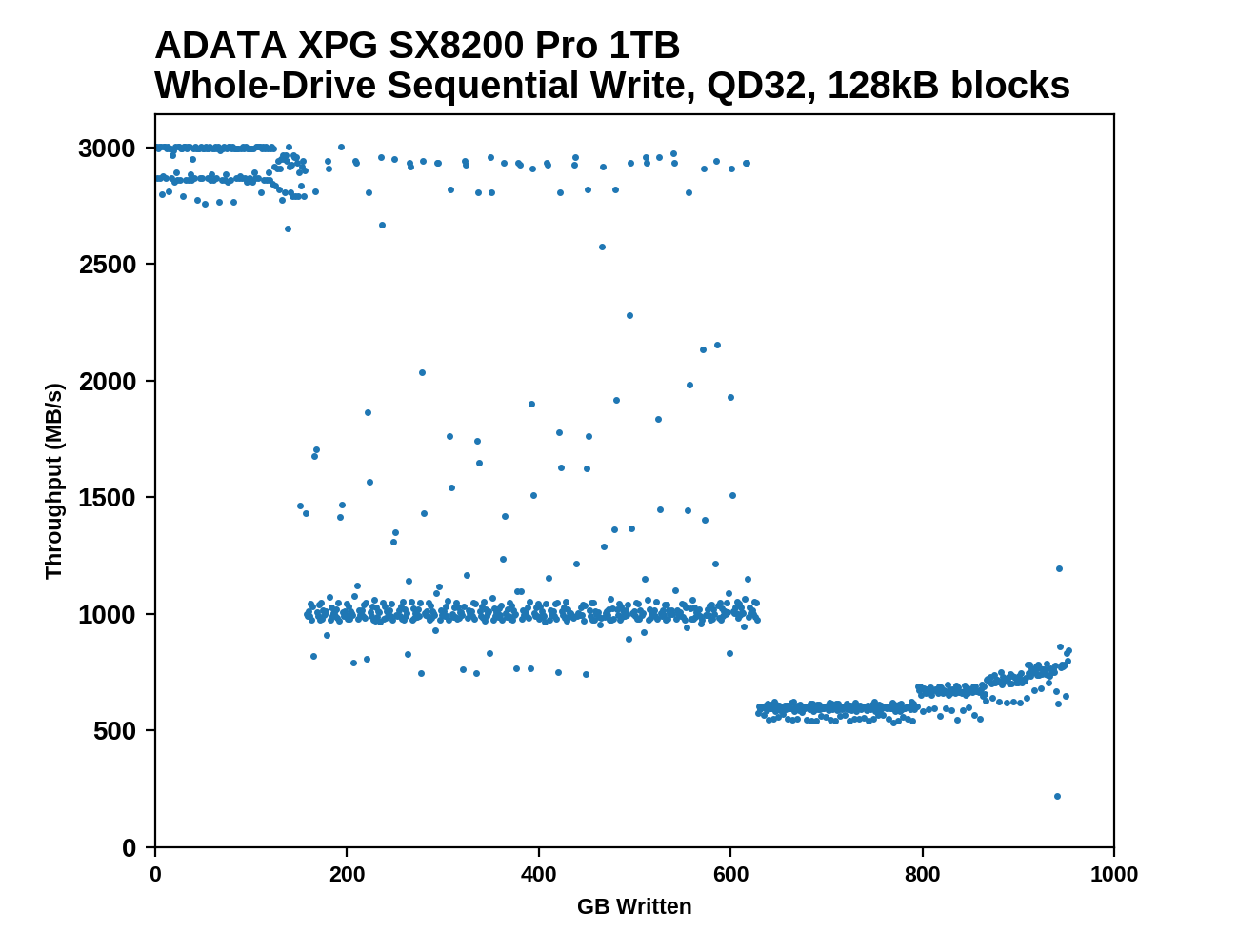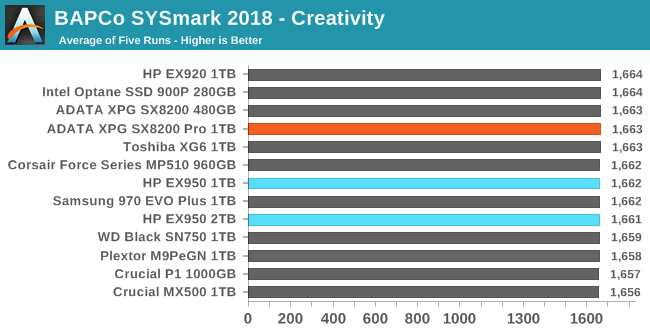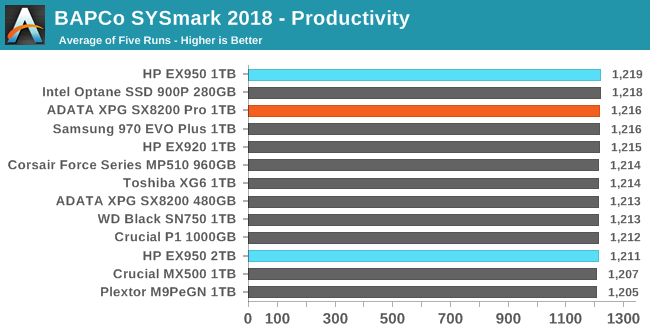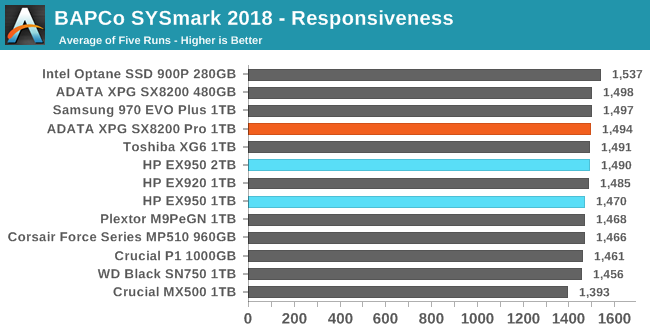Comparing Two 1TB NVMe Drives with Same NAND, Same Controller: XPG SX8200 Pro vs HP EX950
by Billy Tallis on February 6, 2019 11:30 AM ESTWhole-Drive Fill: Testing SLC Cache Size
Most modern drives, in order to accelerate writing speed, designate a part of the drive as an 'SLC cache'. This is part of the storage that acts in 'single bit-per-cell' mode, which allows for faster reads and writes. The reason why it isn't used across the whole drive is that it doesn't allow as much data to be stored in the same area (TLC is three bits per cell, so 3x the density). As the user puts a sustained file write on the drive, this SLC cache will fill up at full speed. If the write size is bigger than the cache and goes without a break, it can spill into normal TLC territory (which is slower). When there is a pause in operation, the drive will compact the data in the SLC cache and move it to TLC blocks, freeing up cache space for future writes. Some drives adjust the size of this SLC cache dynamically based on the amount of free space left, while others have it as a fixed capacity.
We test this function as part of our review, to see how different drives react to a sustained write across the drive without a pause.
Testing Our Drives
This test starts with a freshly-erased drive and fills it with 128kB sequential writes at queue depth 32, recording the write speed for each 1GB segment. This test is not representative of any ordinary client/consumer usage pattern, but it does allow us to observe transitions in the drive's behavior as it fills up. This can allow us to estimate the size of any SLC write cache, and get a sense for how much performance remains on the rare occasions where real-world usage keeps writing data after filling the cache.
 |
|||||||||
The process of filling up a SM2262EN drive with sequential writes can be divided into three distinct phases. First is writing to the SLC cache at around 3 GB/s. The SM2262EN drives have the largest write caches we've seen in a TLC drive: where the 1TB HP EX920's speed first drops after about 136 GB, the 1TB SX8200 Pro lasts for about 150 GB and the 1TB HP EX950 goes slightly further with its first significant speed drop occurring after 156 GB. At this point, just shy of half of the drive's NAND cells are being treated as SLC.
Once that fills up, we see a middle phase where the writes mostly bypass the SLC cache and go straight to TLC, at around 1 GB/s for the 1TB models and 1.5 GB/s for the 2TB. During this middle phase there is some background work to flush the SLC cache which occasionally gets in the way of writing new data, but also means there are frequent momentary bursts back up to SLC write speed.
The final phase occurs when the TLC portion of the drive fills up and the drive has to start shrinking the SLC cache. Each new chunk of data the host sends requires the controller to free up some space by folding data in the SLC cache into TLC blocks, and these competing processes impose a significant performance hit now that the folding cannot be treated as low-priority. However, as the drive approaches 100% full, the SLC cache shrinks and performance creeps back up toward what we saw during the middle phase.
 |
|||||||||
| Average Throughput for last 16 GB | Overall Average Throughput | ||||||||
The SM2262EN drives improve over their predecessors in post-SLC write speeds, but still lag far behind most other high-end TLC drives. The performance stays above SATA speeds for the entire drive fill process, but Samsung, Toshiba and Western Digital all have TLC drives that can maintain 1.5GB/s. The 2TB EX950 averages about that speed during the middle phase of writing directly to TLC, but its overall average is only about 1.3GB/s, and the 1TB models average under 1GB/s.
BAPCo SYSmark 2018
BAPCo's SYSmark 2018 is an application-based benchmark that uses real-world applications to replay usage patterns of business users, with subscores for productivity, creativity and responsiveness. Scores represnt overall system performance and are calibrated against a reference system that is defined to score 1000 in each of the scenarios. A score of, say, 2000, would imply that the system under test is twice as fast as the reference system.
SYSmark scores are based on total application response time as seen by the user, including not only storage latency but time spent by the processor. This means there's a limit to how much a storage improvement could possibly increase scores, because the SSD is only in use for a small fraction of the total test duration. This is a significant difference from our ATSB tests where only the storage portion of the workload is replicated and disk idle times are cut short to a maximum of 25ms.
| AnandTech SYSmark SSD Testbed | |
| CPU | Intel Core i5-7400 |
| Motherboard | ASUS PRIME Z270-A |
| Chipset | Intel Z270 |
| Memory | 2x 8GB Corsair Vengeance DDR4-2400 CL17 |
| Case | In Win C583 |
| Power Supply | Cooler Master G550M |
| OS | Windows 10 64-bit, version 1803 |
Our SSD testing with SYSmark uses a different test system than the rest of our SSD tests. This machine is set up to measure total system power consumption rather than just the drive's power.



Storage improvements make little to no difference in SYSmark performance on our quad-core test system with integrated graphics. Only the responsiveness test shows a spread of scores that's wider than the normal variation between runs, and the gap between a SATA SSD and an Intel Optane SSD is still only 10%, with high-end TLC NVMe drives falling in the middle.
Energy Usage
The SYSmark energy usage scores measure total system power consumption, excluding the display. Our SYSmark test system idles at around 26 W and peaks at over 60 W measured at the wall during the benchmark run. SATA SSDs seldom exceed 5 W and idle at a fraction of a watt, and the SSDs spend most of the test idle. This means the energy usage scores will inevitably be very close. A typical notebook system will tend to be better optimized for power efficiency than this desktop system, so the SSD would account for a much larger portion of the total and the score difference between SSDs would be more noticeable.

The energy consumption scores show more meaningful differences between drives than the performance scores, though it's still not enough to matter to desktop use. The NVMe drives are all still clearly more power-hungry than decent SATA drives, but the SM2262EN drives close the gap slightly.










42 Comments
View All Comments
Mikewind Dale - Wednesday, February 6, 2019 - link
That drop in performance for a full drive in the Heavy - and even the Light!! - tests is worrying. They're right around the level of a SATA SSD.My question is, how full is full? If you fill the drive up 99%, is its performance closer to empty or full? With all my SSDs, I typically leave about 10% of the drive unallocated (unpartitioned). How would the drive perform in this state?
I would be interested in seeing results for a drive that is almost full, but not quite full. I imagine that most people don't use their drives up until the final MB is used. Still, if a cost-conscious person is trying to get their money's worth, they might use the drive until it's 90-something percent full. Until recently, I was using a 512 GB SATA SSD with a real capacity of 476.8 GB. I used it until I was using 420 GB, at which point I upgraded to a 2 TB drive. So I was using 88% of its capacity. To me, that seems like a reasonable usage to test - not quite full, but almost full.
Targon - Wednesday, February 6, 2019 - link
I would suspect that the reason for this might be thermal throttle issues. Throw a heat sink on there, and the performance downgrade might disappear. The versions with a pre-installed heatsink might be worth the money, depending on how much it would cost to buy a SSD heatsink at this point(I haven't looked).BillyONeal - Wednesday, February 6, 2019 - link
Seems more likely to be reduction in the size of the SLC cache -- see the the filling the drive tests where there are 3 distinct phases depending on how much space is actually in use.jabber - Thursday, February 7, 2019 - link
I must admit I still leave a few GB spare/unallocated on any SSD I install. 2GB on a 120GB, 4GB on a 240GB and 8GB on a 500GB. Old habits.reactor_au - Thursday, June 13, 2019 - link
I was wondering the same thing, how full can one get before performance drops off the cliff like in the benchmarks? Its a very import detail to omit!Luckz - Friday, November 29, 2019 - link
At 80% full it was really tragic in this review of the 256GB size https://pclab.pl/art79361-9.htmlMikewind Dale - Wednesday, February 6, 2019 - link
I also notice that these drives don't have an active power state less than 3.8W. That's unfortunate, because as Ganesh T S noted in his Anandtech review of the MyDigitalSSD M2X M.2 NVMe SSD Enclosure, that enclosure will only work with SSDs that have an active power state less than 3.8W.I think this is important because it determines whether you can continue to use the SSD as a portable drive after you upgrade later. If you replace your 2 TB with a 4 or 8 TB SSD someday in the future, it will be nice to know that you can repurpose your 2 TB as an external drive.
Also, it determines whether you can easily upgrade your SSD when all your M.2 slots are full. Whenever I upgrade a SATA boot drive, I typically use an external USB enclosure to clone the current SATA drive (still installed internally) to the new SATA drive (inside the enclosure). Then I can swap the two drives, and my computer will transparently use the new drive. With M.2, this is even more important because many motherboards have only two M.2 sockets. So if you have both M.2 sockets filled and try to upgrade one of the M.2 drives, you'll have a bit of a challenge. You could buy a PCIe-M.2 card and use that, but using an external USB enclosure is more convenient.
So I'd like to see more M.2 drives with a sub-3.8 W active power state. The Samsung 970 EVO Plus has a 3.4 W active state, so it passes this test.
MrSpadge - Wednesday, February 6, 2019 - link
I love ADATA's naming scheme! It's so easily memorable and has more X's than any other brand.eddieobscurant - Wednesday, February 6, 2019 - link
Nice review , as always although I disagree with your conclusion. Peak performance is what most people want.Billy Tallis - Wednesday, February 6, 2019 - link
My reviews are intended to advise consumers who are buying SSDs to increase their productivity, not people who are trying to set a high score on Crystal Disk Mark.People who care about real-world productivity rather than CDM scores should recognize that imperceptible improvements to peak performance are probably not worth the sacrifice of significant regressions in performance on niche heavy workloads. For a lot of users, both SM2262 and SM2262EN drives are fast enough. Beyond those lighter use cases, I think it will be more common to find the SM2262EN coming up short in a meaningful way than to find it providing a tangible performance advantage over SM2262.